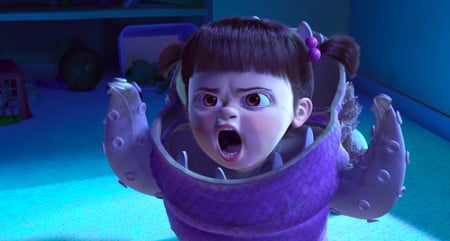
Cory Milles is a teacher who uses Blake’s ideas to challenge and enrich his students’ understanding of story structure. He is also a writer and has been published in the books LOST Thought and LOST Thought University Edition. He blogs about writing and story structure at Attacking Ideas 101, and his YA novel Paradox is available on Amazon.com.
Monsters University is another big, deserving hit for Disney Pixar, following in the pawprints of Monsters, Inc. If you were to approach someone and ask what genre either of the movies was, he or she would most likely say it was a comedy, or perhaps an adventure. But through Blake Snyder’s insights, we know better: the original film is a Monster in the House and the newer movie is a Buddy Love. How do these different genres play out… and end up as such enjoyable entertainment and box-office hits?
It’s ironic that Monsters, Inc. best fits within the MITH story type. It has all of the necessary ingredients: a monster, a house where the monster runs amok and threatens the characters and their livelihoods, and a secret sin that has unleashed the monster. Of course, this is a family-friendly MITH story.
Even though the film’s title might lead one to believe that the protagonists are the monsters in the story, using Blake’s story types, we know who the real monster is. The monster in the story is actually Boo, the little girl who escapes the confines of her room and enters into Monstropolis. A door had been left out, and as Sully entered it to investigate, he accidentally let her into his world. A child would seem harmless, so why would Boo be considered the monster in the story? The answer is hinted at nicely during a training session in the Set-Up: human children are toxic, and they must never be allowed into the monsters’ world.

The house in the story is Monstropolis, the city the monsters live in. Powered by the screams of sleeping children, it is the city Monsters, Inc. seeks to maintain. Once Sully discovers Boo, he must convince his best friend Mike to help him contain the threat. Of course, trying to wrangle a human toddler is no easy matter, and she soon begins to wreak havoc by causing panic in all of Monstropolis.
The key element to making Monsters, Inc. a MITH story is the sin. At first, when Sully finds the activated door that Boo emerges from, he assumes someone just left it out by accident. He soon realizes that his nemesis, Randall, is behind it, and he reasons that Randall is trying to cheat at becoming the head Scarer. Later, Sully discovers that Randall was trying to use a device engineered to extract screams from children in a horrifying manner.
While trying to alert his boss, Mr. Waternoose, about the discovery, Sully is soon shocked to learn that not only did Waternoose know about the scheme, but was actually behind it. The sin is what ultimately has allowed the monster to enter the house, and it is this sin that must be exposed before the story can be fully resolved.
As soon as it was revealed that there would be a second film in the series, fans speculated on what the storyline would be. Would the writers play it safe and follow a similar plot, writing another MITH tale? Some thought it would include the return of Boo, the little girl, perhaps grown up now. While it might have been the “safe” path to take, the writers tackled a different story type, separating it from its predecessor.
Monsters University is a Buddy Love story. As a prequel, it explores the relationship of Mike and Sully as seen in the first film. In the original, audiences knew that these two characters were inseparable friends, standing by each other’s side no matter what happened, even though there were a few bumps in the road. Monsters University explores how that strong bond came to be. And like all Buddy Love tales, it takes some time and hits some rough patches along the way.

Monsters University focuses on the college lives of Mike and Sully and how they went from rivals to friends. Ever since childhood, Mike had been picked on because of his size, and he uses this negativity as a force for motivation as he seeks the professional life of becoming a Scarer for Monsters, Inc. But first, he must attend college, and it is here that he meets Sully. Sully has a different attitude about what it takes to be a Scarer, leaning on the legacy of his father. Whereas Mike is all about studying and understanding details, Sully lets things come naturally, relying on his gut instinct.
The movie has all of the important elements that Blake identified to make it a Buddy Love film. First, there is the incomplete hero. In this case, either Mike or Sully could be identified as the one who is incomplete. Mike needs to put his trust in more than academics, and Sully needs to pay a little bit more attention to them. Each character is the other’s counterpart. And along the way, they will face complications in their developing friendship.
For example, in their efforts to out-perform each other on a big exam, they end up getting kicked out of the program, each of their dreams shattered by their actions. Trying to gain favor with the dean, they reluctantly team up with the Oozma Kappa fraternity to take part in the Scare Games. It is through these events that they must learn to trust each other and learn from each other.
Because of the nature of the Scare Games, some might want to classify the story as a Golden Fleece, or even a Buddy Fleece. However, the focus of the story is not simply on winning the competition; it is on the relationship of Mike and Sully as they discover who they really are deep down inside and learn that they need each other to attain their dreams. In this film, Mike and Sully face their faults and their failures in a wonderful Dark Night of the Soul scene, each baring their souls to the other as they realize that they are, indeed, friends.
Both of the films do a wonderful job of capturing the right emotions at the right moments, hitting the Beats as needed. Nowhere is this better seen than in the All Is Lost beats.
In Monsters, Inc., the All Is Lost moment happens after Sully races into a training session, interrupting Mr. Waternoose to tell him about Randall’s devious actions. Rather than listen to Sully, Waternoose insists on a demonstration from his best Scarer, and Sully reluctantly complies, roaring at the fake child in the bed. Unfortunately, Boo was hiding behind it, horrified at seeing Sully in such a way. As she cries and runs into Waternoose’s arms, Sully looks at the video stills, seeing himself for the first time as a child would.
He is devastated that Boo is now scared of him, and to make matters worse, Waternoose reveals his true intentions, banishing Mike and Sully through a door from which they can never return. As Sully tries to reopen the door, only to find nothing on the other side, he opens and closes it over and over again. Truly, All Is Lost for him: he has lost Boo’s trust and love, and she is now in danger with no one else having any knowledge about her plight.
Monsters University also accomplishes the All Is Lost moment well. As a Buddy Love movie, the moment should reflect a loss in the relationship, and the story definitely delivers. After a period of training for the Scare Games, Mike and Sully have finally become good friends. During the last event of the competition, a scaring simulation, Mike squares off against the opposing fraternity’s most frightening member, propelling his team to a surprise victory.
After everyone celebrates, Mike discovers the sad truth: Sully has cheated by sabotaging the simulator to help Mike win. Mike is devastated. Not only is their win false, but he now learns about Sully’s true feelings. Sully doesn’t believe Mike is scary, but he only pretended to believe it. All Is Lost for them: not only did they actually lose the Games, but their relationship is about to crumble.
It’s no surprise that both of these movies strike a chord with their audiences. The writers use humor and emotion to tell good stories. And while at their bare basics, these movies are Monster in the House and Buddy Love tales, it is the ability of the writers to use the building blocks of these genres to put together compelling stories that resonate so successfully.
Cory Milles
1 Comment
Leave a Reply Cancel reply
You must be logged in to post a comment.









Excellent blog, Cory. Insightful and informative, and another great reminder of how Blake’s ideas concerning genre are among his most powerful and lasting contributions to the writing community.